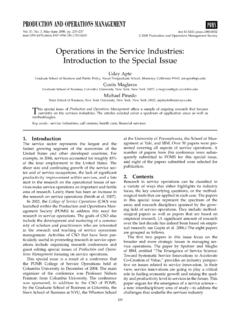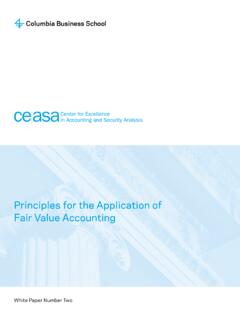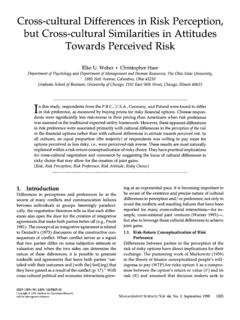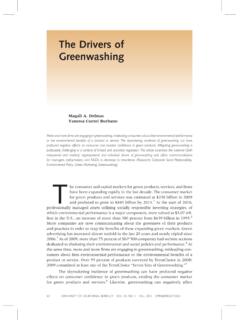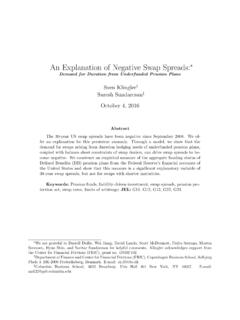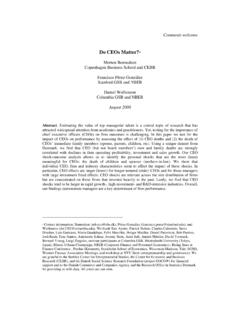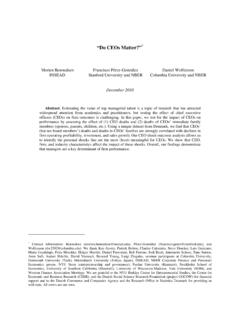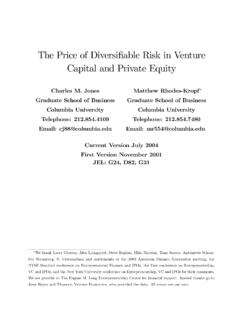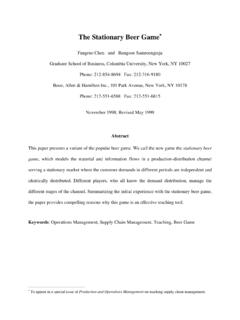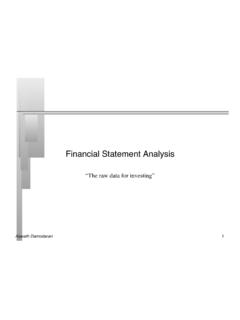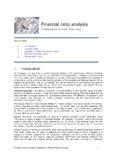Transcription of Modeling Sustainable Earnings and P/E Ratios Using ...
1 Modeling Sustainable Earnings and P/E Ratios Using financial Statement information Stephen H. Penman Graduate School of Business Columbia University and Xiao-Jun Zhang Haas School of Business University of California, Berkeley March, 2004 Stephen Penman s research is supported by the Morgan Stanley Scholarship Fund at Columbia University. Modeling Sustainable Earnings and P/E Ratios Using financial Statement information ABSTRACT: The financial statement analysis in this paper yields a summary number that informs about the sustainability (or persistence) of Earnings and the trailing P/E ratio. The P/E ratio is the amount paid for a dollar of current Earnings .
2 Investors buy future Earnings , so should pay less for current Earnings if the Earnings cannot be sustained in the future. While income statements identify some transitory items, the investor remains uncertain about whether Earnings are Sustainable . This paper specifies and estimates a model that employs financial statement information to indicate the probability of Earnings being Sustainable . The paper also specifies and estimates a P/E model that incorporates that information . In out-of-sample prediction tests, the analysis reliably identifies unsustainable Earnings and explains cross-sectional differences in P/E Ratios . Further, stock returns can be predicted when the market s P/E ratio differs from that indicated by the model.
3 Keywords: Sustainable Earnings ; price- Earnings Ratios ; financial statement analysis Data Availability: All data employed in this study are commercially available from sources identified in the text. 1 Modeling Sustainable Earnings and P/E Ratios Using financial Statement information When analysts talk of Sustainable Earnings , they presumably are concerned about the extent to which reported Earnings will persist into the future. However, identifying Sustainable (or persistent) Earnings is problematical. Measures of pro forma Earnings and core Earnings have been proposed, but each has drawn criticism.
4 This paper identifies Sustainable Earnings from information in financial statements. The analysis exploits the structural features of the accounting for Earnings : In calculating Earnings under the discipline of double entry, the accounting leaves a trail such that (unsustainable) Earnings cannot be booked without also affecting the balance sheet. Reducing deferred revenues or accrued expenses in order to temporarily increase Earnings ( cookie jar accounting ) are just two examples where a trail is left in the balance sheet. The paper produces a measure of Sustainable Earnings by following the trail that Earnings measurement leaves in the financial statements.
5 Measures of Sustainable Earnings , so obtained, are then applied to the question of how reported Earnings are priced. Equity analysts are interested in the sustainability of Earnings because they understand that equity values are based on expected future Earnings , not current Earnings ; investors buy future Earnings , so it is said. Yet it is common to refer to the trailing P/E ratio which prices current Earnings that may not be Sustainable . Investors should pay less for current Earnings if those Earnings are not Sustainable ; if Earnings are temporarily high, so are expected to decline in the future, P/E Ratios should be lower than if Earnings were Sustainable .
6 Correspondingly, if Earnings are temporarily depressed, and so are expected to increase, P/E Ratios should be higher than if Earnings were to be sustained at their current level. Accordingly, a measure of Sustainable Earnings informs about the P/E ratio. The paper builds an empirical model of the P/E ratio that incorporates financial statement information about the sustainability 2of Earnings , and finds that this model has considerable power in explaining cross-sectional differences in traded P/E Ratios ; line item information that supplements Earnings in the financial statements is considerably effective in explaining how those Earnings are priced in the market.
7 Market P/E Ratios to which our model is fitted incorporate information about the sustainability of Earnings only if the market prices Earnings efficiently. In light of this caveat, we investigate whether information in financial statements about the sustainability of Earnings predicts future stock returns, with an affirmative answer. We also find that deviations of traded (market) P/E Ratios from those implied by our estimated P/E model also predict stock returns. While one cannot rule out risk explanations which we attempt to control for this result raises questions about whether the market efficiently prices the information in financial statements about the sustainability of Earnings .
8 1. Laying out the Issues. The paper builds on previous research, so it is important to distinguish its point of departure. Like other papers, the paper involves Earnings forecasting; it models the P/E ratio; and it uses fundamentals as screens to predict stock returns. We introduce the paper under headings that pertain to the three topics. Earnings Forecasting and Earnings Persistence Assessing Earnings persistence is a form of Earnings forecasting that takes current Earnings as a starting point. Research on Earnings forecasting in the modern era begins with Ball and Watts (1972) where current Earnings are depicted as following a martingale process, and thus Sustainable .
9 Subsequent research modifies this view. Some papers take the path of estimating persistence parameters from Earnings time series, in the mode of Komendi and Lipe 3(1987). Other papers defer to accounting information beyond past Earnings for indications of persistence. Our paper is in the latter tradition. Freeman, Ohlson and Penman (1982) show that by adding just one line item book value to current Earnings , future Earnings changes are probabilistically predictable; if Earnings are high relative to book value, Earnings are likely to be temporarily high, and if Earnings are low relative to book value, they are likely to be temporarily low.
10 Ou and Penman (1989a) utilize further financial statement Ratios in forecasting changes in Earnings . Lev and Thiagarajan (1993) and Abarbanell and Bushee (1997) consider fundamental measures popular with analysts. Lipe (1986) and Fairfield Sweeney and Yohn (1996) show that line-item analysis of the income statement improves forecasts. Sloan (1996) shows that accrual Earnings have a different persistence than cash Earnings and Richardson, Sloan Soliman and Tuna (2002) extend that analysis to various components of accruals. Chan, Chan, Jagadeesh and Lakonishok (2001) report similar findings. Fairfield and Yohn (2001) report that a Du Pont decomposition of operating profitability improves forecasts of changes in profitability in the future, and Fairfield, Whisenant and Yohn (2003) apply financial statement measures of growth to the assessment of persistence.
